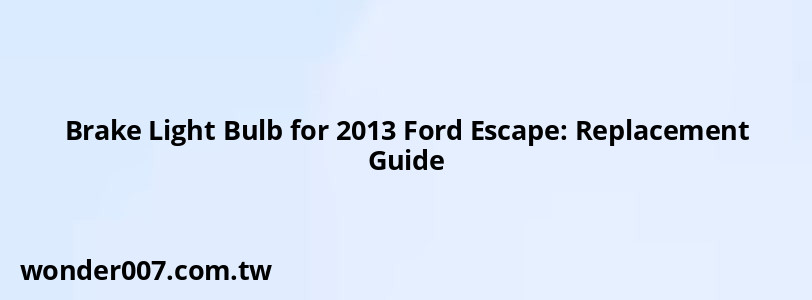Brake Light Bulb for 2013 Ford Escape: Replacement Guide

The brake light bulb for the 2013 Ford Escape is essential for ensuring safety on the road. This guide provides detailed information on the type of bulb needed, how to replace it, and important tips to keep in mind.
Brake Light Bulb Specifications
The 2013 Ford Escape uses two types of brake light bulbs:
- Rear Brake Light: 3156 (also compatible with 3157)
- High-Mounted Brake Light: 912 or LED
These bulbs are typically halogen, but LED options are available as upgrades. It's crucial to select the correct bulb type to ensure proper functionality and compliance with safety standards.
How to Replace the Brake Light Bulb
Replacing the brake light bulb in your Ford Escape can be done easily with some basic tools. Follow these steps for a successful replacement:
1. Gather Tools: You will need an 8mm socket or driver, a flathead screwdriver, and possibly a rag to clean any debris.
2. Access the Bulb:
- Open the rear hatch of your Escape.
- Locate the tail light assembly; it is usually secured by screws or clips.
- Remove any screws using the 8mm socket and gently pull the assembly towards you to disengage it.
3. Remove the Old Bulb:
- Identify the burnt-out brake light bulb.
- Turn the bulb socket counterclockwise to remove it from the assembly.
- Carefully pull out the old bulb.
4. Install the New Bulb:
- Insert the new bulb into the socket without touching the glass part directly, as oils from your fingers can shorten its lifespan.
- Reinsert the socket into the assembly and turn it clockwise until secure.
5. Reassemble:
- Place the tail light assembly back into its original position.
- Secure it with screws or clips that were removed earlier.
- Test the new brake light by pressing the brake pedal to ensure it illuminates properly.
Important Tips
- Always replace brake light bulbs in pairs to maintain consistent brightness and reduce future replacements.
- If using LED bulbs, check their compatibility with your vehicle's electrical system, as some may require a resistor to prevent flickering.
- Regularly inspect your brake lights for functionality; this is vital for your safety and that of others on the road.
FAQs About Brake Light Bulb Replacement
- How often should I replace my brake light bulbs?
It's advisable to check and replace them at least once a year or whenever they burn out. - Can I use any type of bulb?
No, always use the specified bulb type (3156/3157 for rear, 912 for high-mounted) for optimal performance. - What if my new bulb doesn't work?
Check if it's installed correctly and ensure there are no issues with the wiring or fuse.
By following this guide, you can ensure that your 2013 Ford Escape remains safe and roadworthy with properly functioning brake lights.
Related Posts
-
What Does The Diesel Particulate Filter Warning Light Mean
31-01-2025 • 239 views -
Chevy Malibu Maxx Key Fob: Complete Guide for Owners
29-01-2025 • 237 views -
2013 Hyundai Elantra Brake Light Socket Replacement
30-01-2025 • 119 views -
Timing Chain Replacement: 2009 Toyota Corolla Guide
29-01-2025 • 183 views -
Prius Red Triangle Light Reset: Step-by-Step Guide
26-01-2025 • 370 views
Latest Posts
-
2015 Chevy Traverse AC Recharge Port Location
01-02-2025 • 423 views -
How To Turn Off Paddle Shifters Mercedes
01-02-2025 • 392 views -
Are O2 Sensors Covered Under Warranty
01-02-2025 • 382 views -
Rear Brake Caliper Piston Won't Compress
01-02-2025 • 363 views -
Power Steering Fluid Leak On Passenger Side
01-02-2025 • 466 views
Popular Posts
-
V12 Engine Costs: What You Need to Know
26-01-2025 • 696 views -
Hino Warning Lights: Understanding Dashboard Alerts
26-01-2025 • 816 views -
Power Steering and ABS Light On: Causes and Solutions
27-01-2025 • 655 views -
Toyota Hiace: Fuel Efficiency Insights for 2025
26-01-2025 • 671 views -
EPC Light: Understanding Causes and Solutions
26-01-2025 • 1075 views
